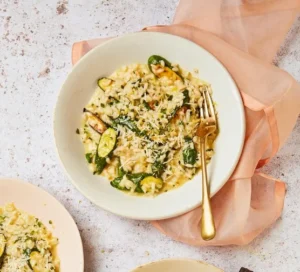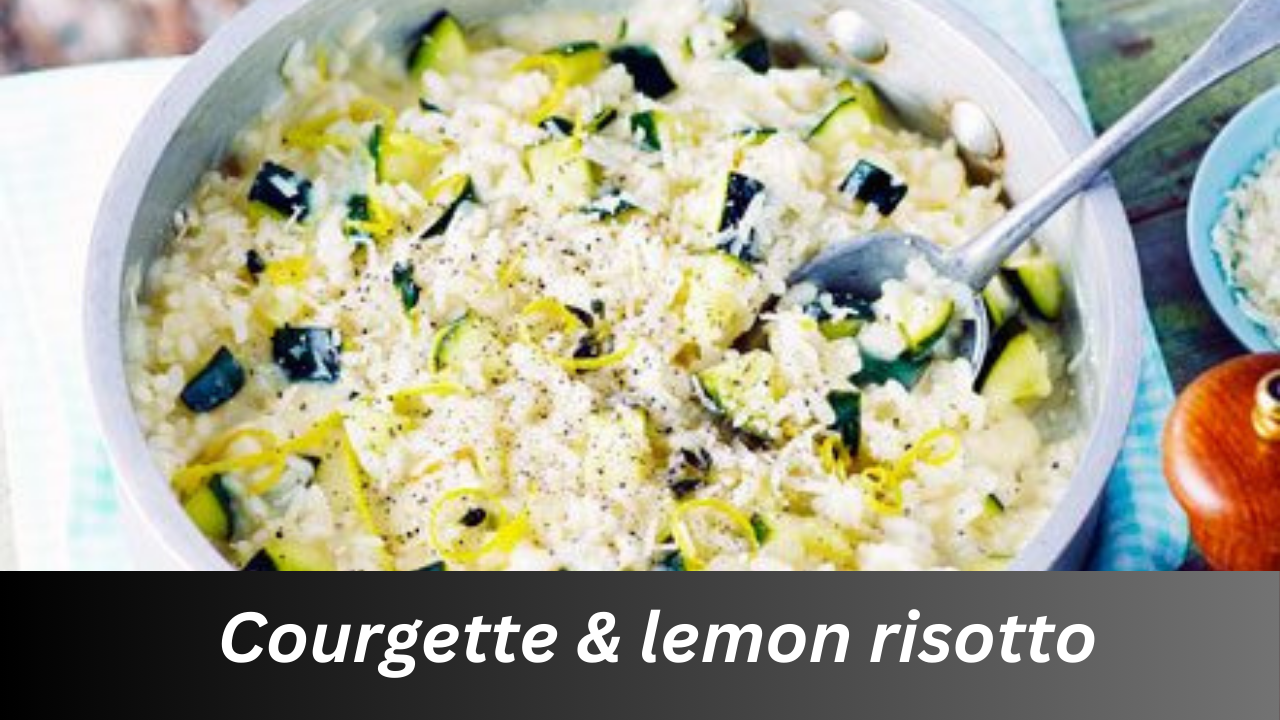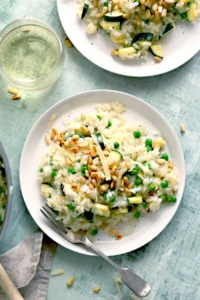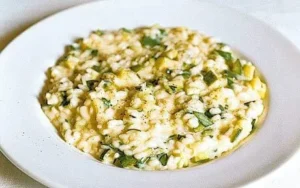Introduction:
Risotto, an iconic dish in Italian cuisine, is renowned for its creamy texture and rich flavors. Among the myriad of risotto variations, courgette (zucchini) and lemon risotto stands out for its fresh, vibrant, and summery appeal.
Combining the subtle sweetness of courgettes with the zesty brightness of lemon, this dish offers a perfect balance of flavors and textures. In this extensive exploration, we delve into the ingredients, preparation techniques, and the intricate steps involved in crafting the perfect courgette and lemon risotto.
Ingredients and Their Importance
- Arborio Rice: The foundation of any risotto, Arborio rice is a short-grain rice known for its high starch content, which is crucial for achieving the desired creamy consistency. The rice grains absorb flavors well while maintaining a slightly firm texture.
- Courgettes (Zucchini): Courgettes add a delicate sweetness and a slightly crunchy texture to the risotto. They are rich in vitamins and minerals, making the dish not only delicious but also nutritious.
- Lemon: Lemon zest and juice are the stars of this dish, providing a refreshing contrast to the creamy rice. The acidity of the lemon juice cuts through the richness, while the zest adds a fragrant, citrusy note.
- Onion and Garlic: These aromatics form the base of the risotto, infusing the dish with depth and complexity. The onion adds sweetness, while the garlic offers a subtle pungency.
- White Wine: A splash of white wine deglazes the pan and adds a layer of acidity and complexity. It enhances the flavors of the other ingredients and gives the risotto a sophisticated touch.
- Vegetable Stock: The stock is gradually absorbed by the rice, imparting a savory depth. Using a good-quality vegetable stock is essential for a flavorful risotto.

- Parmesan Cheese: Grated Parmesan cheese is stirred into the risotto towards the end, adding a rich, umami flavor and contributing to the creamy texture.
- Butter: Butter is used for sautéing the aromatics and is also stirred in at the end to enrich the risotto and give it a glossy finish.
- Olive Oil: Used in combination with butter, olive oil adds a fruity note and helps to sauté the vegetables without burning them.
- Fresh Herbs: Fresh herbs such as basil or parsley are often used as a garnish, adding a burst of color and freshness.
Preparation Techniques
- Preparing the Courgettes: Begin by washing the courgettes thoroughly. Depending on the desired texture, they can be grated, diced, or sliced thinly. Grated courgettes will blend seamlessly into the risotto, while diced or sliced courgettes will provide a more pronounced texture.
- Zesting and Juicing the Lemon: Use a fine grater to zest the lemon, ensuring only the yellow outer layer is removed, as the white pith can be bitter. Cut the lemon in half and juice it, straining out any seeds.
- Sautéing the Aromatics: In a large, heavy-bottomed pan, heat a combination of butter and olive oil over medium heat. Add finely chopped onion and cook until translucent, about 5-7 minutes. Add minced garlic and cook for an additional minute, ensuring it does not brown.
- Toasting the Rice: Add the Arborio rice to the pan and stir to coat each grain with the butter and oil. Toast the rice for 2-3 minutes, stirring constantly, until the edges of the grains become translucent.
- Deglazing with White Wine: Pour in the white wine and stir until it is mostly absorbed. This step not only adds flavor but also helps to release the starches from the rice, which is essential for the risotto’s creamy texture.
- Gradual Addition of Stock: Begin adding the warm vegetable stock one ladleful at a time, stirring frequently. Wait until most of the liquid is absorbed before adding more stock. This process, known as “risotto method,” ensures the rice cooks evenly and releases its starches gradually.
- Incorporating the Courgettes: Add the prepared courgettes halfway through the cooking process. This allows them to soften and meld with the rice while retaining some of their texture.
- Adding Lemon Zest and Juice: Once the rice is al dente and the risotto has reached a creamy consistency, stir in the lemon zest and juice. Adjust the amount of lemon to taste, keeping in mind that the acidity will intensify the flavors.
- Finishing with Parmesan and Butter: Remove the pan from heat and stir in grated Parmesan cheese and a knob of butter. This step, known as “mantecatura,” enriches the risotto and gives it a luxurious finish.
- Seasoning and Garnishing: Taste the risotto and adjust the seasoning with salt and freshly ground black pepper. Garnish with fresh herbs and a drizzle of olive oil before serving.
Detailed Step-by-Step Recipe
Ingredients:
- 1 1/2 cups Arborio rice
- 2 medium courgettes (zucchini), grated or diced
- 1 lemon (zest and juice)
- 1 small onion, finely chopped
- 2 garlic cloves, minced
- 1/2 cup dry white wine
- 4-5 cups vegetable stock, kept warm
- 1/2 cup grated Parmesan cheese
- 2 tablespoons butter
- 2 tablespoons olive oil
- Salt and freshly ground black pepper, to taste
- Fresh basil or parsley, for garnish
Instructions:
- Prepare the Courgettes: Wash and grate or dice the courgettes. Set aside.
- Zest and Juice the Lemon: Zest the lemon using a fine grater and juice it, ensuring no seeds remain. Set both zest and juice aside.
- Sauté the Aromatics: In a large, heavy-bottomed pan, heat the butter and olive oil over medium heat. Add the chopped onion and sauté until translucent, about 5-7 minutes. Add the minced garlic and cook for an additional minute, taking care not to let it brown.
- Toast the Rice: Add the Arborio rice to the pan and stir to coat the grains with the butter and oil. Toast the rice for 2-3 minutes, stirring constantly, until the edges of the grains become translucent.
- Deglaze with White Wine: Pour in the white wine and stir until it is mostly absorbed. This step will release the starches from the rice, contributing to the creamy texture of the risotto.
- Gradual Addition of Stock: Begin adding the warm vegetable stock one ladleful at a time, stirring frequently. Wait until most of the liquid is absorbed before adding more stock. Continue this process until the rice is al dente, about 18-20 minutes.
- Incorporate the Courgettes: About halfway through the cooking process, add the grated or diced courgettes. Continue to stir and add stock as needed.
- Add Lemon Zest and Juice: Once the rice is al dente and the risotto has reached a creamy consistency, stir in the lemon zest and juice. Adjust the amount of lemon to taste, keeping in mind that the acidity will intensify the flavors.
- Finish with Parmesan and Butter: Remove the pan from heat and stir in the grated Parmesan cheese and a knob of butter. This step will enrich the risotto and give it a luxurious finish.
- Season and Garnish: Taste the risotto and adjust the seasoning with salt and freshly ground black pepper. Garnish with fresh herbs such as basil or parsley and a drizzle of olive oil before serving.
Serving Suggestions and Variations
Serving Suggestions:
- Serve the risotto immediately while it is still warm and creamy.
- Pair it with a crisp, chilled white wine such as Sauvignon Blanc or Pinot Grigio to complement the lemony notes.
- Accompany the risotto with a simple green salad dressed with lemon vinaigrette to enhance the citrus flavors.
Variations:
- Seafood Addition: Add sautéed shrimp or scallops towards the end of the cooking process for a luxurious seafood twist.
- Herb Variations: Experiment with different herbs such as dill, mint, or chives to add unique flavors to the risotto.
- Cheese Alternatives: Substitute Parmesan with Pecorino Romano or goat cheese for a different cheesy profile.
- Vegan Option: Replace butter with a vegan alternative and use nutritional yeast instead of Parmesan for a vegan-friendly version.



